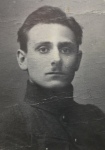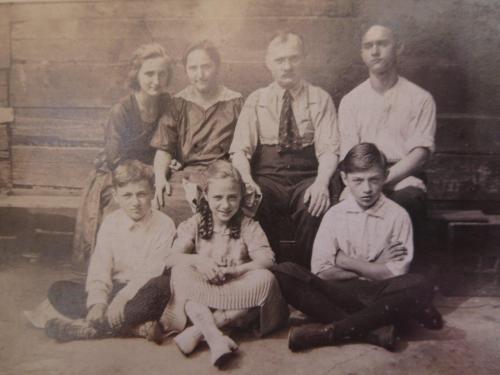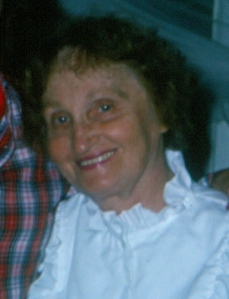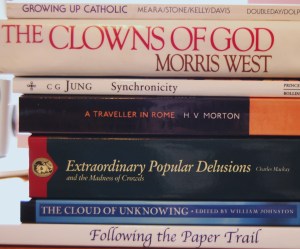One of the great loves of my life has been science fiction. After just one sentence, I can guarantee that about a quarter to a third of you readers are nodding your head in agreement, or saying, “I knew I liked her for a reason!” But the rest of you probably groaned – that is, assuming you didn’t skip the post totally based on the title alone. To all of you groaners – this post’s for you!
Many people dislike science fiction (sf) because their image of it consists of spaceships, aliens, and other planets. But sf is much more than just those topics, and its range is so broad that there is truly something for everyone – even genealogists. One category of science fiction that is sure to please genealogists is time travel. Fantastic? Unrealistic? Yes, that’s why it’s called fiction. But, boy, is it fun! Don’t we travel back in time every time we search through old documents to find our ancestors? Or look at old photographs trying to imagine what life was really like back then? When I read some sf authors, especially Jack Finney, I feel as though I am walking through the doors of the Virtual Dime Museum or entering the past by stepping into a Shades of the Departed photograph. Here are my picks for the best science fiction stories for genealogists.
The Love Letter ~ by Jack Finney
This is my favorite short story by Jack Finney, whose most famous work is the novel Time and Again about travel to 19th Century New York. Finney’s love and respect for the past permeates this story as well, which was written in 1959 and takes place in 1962. A young man named Jake buys an antique desk, one that is full of pigeonholes and little drawers. One night he examines his find more closely and finds a hidden compartment behind one of the drawers. There he finds some old writing paper, envelopes, and a bottle of ink. But there is also a letter – a love letter.
The letter is dated 1882 and a young woman, Helen, laments her impending marriage by writing with longing to her “Dearest”, who exists only in her mind. “I speak with you in my mind and heart: would you existed outside of them!”
Touched by this woman’s words from so long ago, Jake is moved to write in response.
The night is a strange time when you’re alone in it, the rest of the world asleep. If I’d found that letter in the daytime I’d have smiled and shown it to a few friends, then forgotten it. But alone here now, window partly open, a cool late-at-night freshness stirring the quiet air, it was impossible to think of the girl who had written this letter as a very old lady or maybe long since dead. As I read her words, she seemed real and alive to me, sitting, or so I pictured her, pen in hand… And my heart went out to her as I stared down at her secret hopeless appeal against the world and time she lived in.
Jake writes a short note telling Helen that she’s a girl he could like. “Do the best you can,” he writes, “in the time and place you are.” Feeling satisfied with his late-night amusement, he suddenly feels moved to mail the letter. He finds a vintage stamp from his childhood collection, and walks to an old post office that had been there since Helen’s time – he even stops at the old house that Helen wrote from, though in the present is suffers from neglect and age. He mails the letter, “feeling foolish but at the same time secretly pleased.”
About a week later, Jake is working at his desk late at night when he thinks of Helen. He realizes that there are two other desk drawers – do they have hidden compartments as well? Finney writes that “the night is a strange time” and even though the city of New York had changed considerably over the decades, there are still “little islands – isolated remnants of the way things once were” and “the boundary between here and then wavers.” Remarkably, Jake finds another letter in the second drawer – addressed to him! By using the stationary, ink, stamps, and post office of Helen’s time, he feels that it crossed that boundary between “here and then”. Helen is desparate to know who he is, and how he knew of her thoughts.
Jake responds again in the same way, but this time he tells her that he is writing from 1962. He tells her he has fallen in love with her, but he can’t explain what was happening. He realizes there is one drawer left that he has not opened, and because he already discovered the contents of the first two, that can not be changed. Since he hasn’t opened the third drawer, there is one more chance for Helen to speak to him.
Mailing the letter in the same way, he nervously waits a week. Opening the final hidden compartment, he finds no letter – but a photograph of Helen. Across the bottom, she writes “I will never forget.”
A long time later, Jake realizes there was one final way for Helen to communicate with him over time. Frankly, any genealogist would have figured this out sooner, but Jake apparently wasn’t into genealogy back in 1962! I won’t spoil the ending and Helen’s final message to Jake, but it is a sweet ending to a bittersweet and magical love story.
What does “The Love Letter” have to do with genealogy? At the end, Jake uses records we use daily to receive his final message. But I chose this story because of the interaction between the past and the present. As genealogists, we “travel” to the past, at least in our minds, when we do our research. I’m sure many of us would like the persons we research to reach out from the past to communicate with us! “The Love Letter” may not seem very science fiction-like, but if you have ever wondered about the past after seeing a document, photograph, or antique, you will enjoy this trip.
Second Chance ~ by Jack Finney
Most of Finney’s short stories involve some blurring of the lines between the past and the present, which is the attraction for genealogists. Another good example of this is his story “Second Chance”. A young man in 1956 has a penchant for “classic” cars, and he spends most of his time restoring a 1923 Jordan Playboy that was nearly demolished in an accident in which its occupants were killed. He takes great care to restore the car by using original materials instead of replacing old parts with newer, modern ones. He finally finishes and takes the car out for a drive. He takes an old road into town, one that had been there before the highway was built, and he amuses himself by singing old songs from the 1920s and enjoying the ride. He begins to think he is in the 1920s…
But my car and I–the way I felt about it, anyway–were almost rejected that night, by the time I live in. And so there in my Jordan, just as it was the year it was new, with nothing about me from another time, the old ’23 tags on my car, moving along a highway whose very oil spots belonged to that year–well, I think that for a few moments, all the chains hanging slack, we were free on the surface of Time. And that moving along that old highway through the summer evening, we simply drifted — into the time my Jordan belonged in.
When he reaches town he realizes that he had somehow driven back in time, and he parks the car to marvel at the old sights. But his car is stolen, and he nearly gets killed as the thief races by him. After walking around town that night, he finds himself back in his own time in the morning – without his cherished car.
Time passes, and the young man falls in love. It just so happens that the girl’s father enjoys old cars, too. In fact, he has a 1923 Jordan Playboy! The narrator realizes it is the car he restored once before, and after hearing the father’s tale he realizes that his trip back in time saved that man’s life. By changing the past without even realizing it, he made it possible to meet the woman he now loved.
“Second Chance” is an easy-going story with a nice twist at the end. While it doesn’t seem like “science fiction”, any story with some sort of time travel is automatically part of the genre. Finney’s sort of time travel rarely involves machines, but instead is brought about by desire and love for the past. If the lines between the past and the present were truly flexible, I’m sure many a genealogist would jump at the chance to take a peak!
Unto the Fourth Generation ~ Isaac Asimov
One of the undisputed kings of the science fiction genre is Isaac Asimov. Indeed, while he is most known for science fiction literature, Asimov should be remembered as one of the most prolific writers of all time, and the most eclectic. He wrote every day, and the end result was hundreds of books ranging from sf to humor and mysteries to non-fiction works on science, religion, and history. His science fiction covered all sub-genres like alien worlds and robots, with an occasional journey into time travel. If traditional sf subjects don’t turn you off, by all means read the story that I consider to be Asimov’s best – “Nightfall”. But, for my genealogist-audience, I wish to highlight a more unusual work in the Asimov canon – “Unto the Fourth Generation”.
Sam Marten is making his way across New York City for an important work appointment. But with every move he makes, he encounters some variation of the same surname. It appears in signs, trucks, businesses, and the address directory of the building he enters. Lewkowitz, Lafkowitz, Lefkowicz. They don’t sound right, he thinks, but he doesn’t know why. All of these coincidental encounters with the strange name makes him restless; his work meeting does not go well. He now feels haunted by these sightings of the variations of this unknown name. Sam walks, running at times, seemingly guided by unknown hands, to a park.
And there on a bench was an old man; the only man in the desolate park. He wore a dark felt cap, with a visor shading his eyes. From underneath it, tufts of gray hair protruded. His grizzled beard reached the uppermost button of his rough jacket. His old trousers were patched, and a strip of burlap was wrapped about each worn and shapeless shoe.
Marten stopped. It was difficult to breathe. He could only say one word and he used it to ask his question: “Levkovich?”
The old man rises and greets Sam Marten by name. He has been looking for him. Marten intuitively knows this old man is named Phinehas Levkovich, and he asks why they are there. The man answers, “because I prayed.” The old man’s daughter left for America with her family. He grew old, and after his sons died he longed to see if his daughter had any sons “in whom [his] soul might yet live and not die.” The man is given two hours to find the first son born of his daughter’s line in America. “My daughter’s daughter’s daughter’s son, have I found you, then, amidst the splendor of the city?”
Sam asks his great-great grandfather for his blessing, one to be passed on to his future sons. The old man says he can go in peace now that he has laid eyes on him, and he disappears. Suddenly, “there was an instant of renewing motion” and Sam finds himself back where the story begins earlier in the day. “Somehow he knew that all would be well with him. Somehow, as never before, he knew…”
One of the more interesting aspects of this story is how it came about. Asimov’s editor remarked that he had been seeing various signs with the name, and he asked if Isaac could write a story about it. When it was published in April 1959 in The Magazine of Fantasy and Science Fiction, the main character was not affected by the “meeting” with his ancestor. Afterwards, a fan was talking to Asimov when his editor asked her what she thought of the story. Her opinion was that the meeting should have affected Sam in some way. When the story was re-published in one of Asimov’s story collections, the ending had changed. And the fan? Years later she became Asimov’s wife, Janet!
“Unto the Fourth Generation” is a rather unusual story, but one that a genealogist might like. Did the meeting really take place since the great-great grandfather had died years before? Why did Sam go back in time a few hours to the beginning of his day? Does it matter? What matters is his sudden feeling of confidence and well-being. Have you ever suddenly felt a calming come over you? Or feel loved? Perhaps we’re being blessed by our great-great grandfather. The story works because of the emotion showed by both the old man and his descendant, and the meaningfulness of their meeting.
Who’s Your Grandaddy? ~ The Grandfather Paradox
Time travel stories can get a little confusing, and there is actually an issue known in the genre of science fiction as the “Grandfather Paradox”. If a time traveler goes back in time and accidentally kills his own grandfather (or any other ancestor) before children are born, wouldn’t the time traveler cease to exist because he never would have been born? There are two short stories by one of the masters of science fiction, Robert A. Heinlein, that seem to get around this paradox. I’m reluctant to write about them, however. Even though I love Heinlein’s work, these two stories give me a headache!
The first is called “All You Zombies” and was written in 1959. A “temporal agent” goes back in time to recruit a young writer. The agent plays the role of a bartender, and the writer tells his life story. The agent/bartender convinces the writer that if he could go into the past, he could change many of the troubled events he described. He goes back to the time of his birth, but…things get a little complicated. It seems as though his past was more troubled than he originally thought. Can you be your own ancestor? Let’s just say that the plot is complicated and includes a sex change operation. It also has a fair amount of humor, given the hilarity of the situation the main character finds himself (herself?) in. Many years before this story, Heinlein used a similar theme in “By His Bootstraps,” published in 1941. Let the lesson be “beware of time travelers” because it could be your future self tricking you!
A story called “Dear Charles” by Murray Leinster, written in 1953, also touches on the theme, but without the confusing paradox. In the 34th Century, Charles receives a letter that was written in the 20th Century by his own 52nd great-grandfather! Charles’ ancestor explains that a series of unfortuanate events are about to unfold, but he urges him not to try to stop them. The ancestor is about to appear, through a time machine from the past, and he will take Charles’ fiance Ginny back with him. As it turns out, Ginny is actually Charles’ 52nd great-grandmother!
And then I smashed Professor Hadley’s time-transporter. I stamped on it, while Joe gazed stupidly at Ginny. I had reason to smash the device. Naturally! If anybody else traveled in time, they might not be as smart as I am, or their descendants might not be as dumb as you, Charles. Something might get messed up. Somebody might marry the wrong person somewhere in the next fourteen centuries, and Ginny might not get born. I wouldn’t risk that!
This story is more light-hearted, and it is told entirely in the form of the letter that the ancestor sends to Charles. I think we’d all like to receive a personal letter from an ancestor, but I doubt anyone would be happy to find out that their betrothed is actually their own ancestor!
That’s a quick peek into the world of science fiction from a genealogist’s perspective! My goal was to “convert” someone who didn’t think they liked science fiction at all into someone who is willing to take a closer look, perhaps at one of the authors I mentioned. Please let me know if I accomplished my goal! And for my fellow science fiction fans out there – and I know there are several genea-bloggers who belong to that group – please add some of your own ideas in the comments! What sf stories do you think a genealogist would love?
Sources:
- Asimov, Isaac. “Unto the Fourth Generation.” The Complete Stories, Volume I. New York: Doubleday, 1990. 575-581.
- Finney, Jack. “Second Chance.” About Time: 12 Short Stories. New York: Simon & Schuster, Inc., 1998. 183-202.
- Finney, Jack. “The Love Letter.” Tales in Time. Edited by Peter Crowther. Clarkston, GA: White Wolf Publishing, 1997. 41-55.
- Heinlein, Robert A. “–All You Zombies–.” Fantasy and Science Fiction Magazine, March, 1959. Available online at <http://ieng9.ucsd.edu/~mfedder/zombies.html>
- Leinster, Murray. “Dear Charles.” A Logic Named Joe. Baen Publishing, June 2005. Available online at <http://www.webscription.net/10.1125/Baen/0743499107/0743499107___3.htm>























